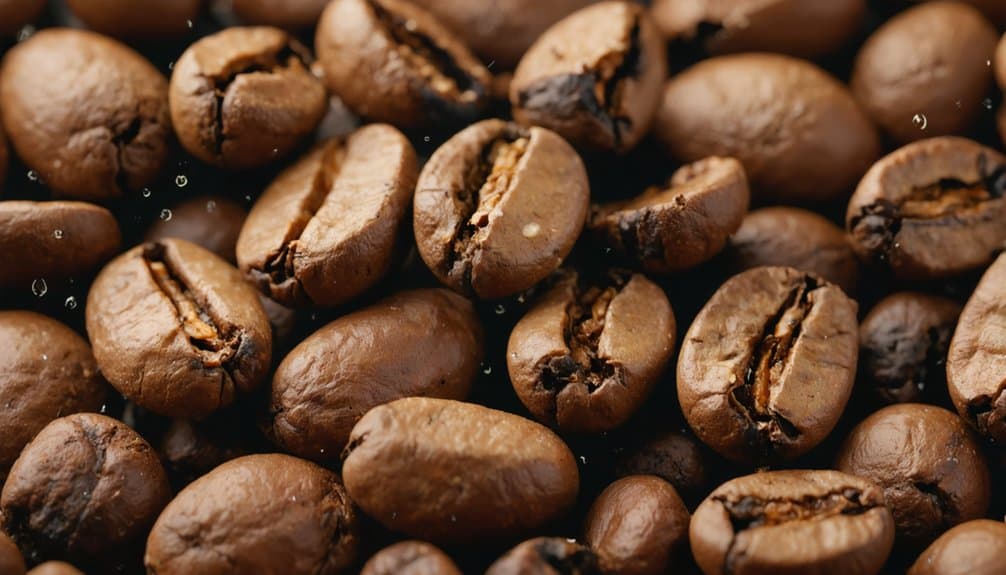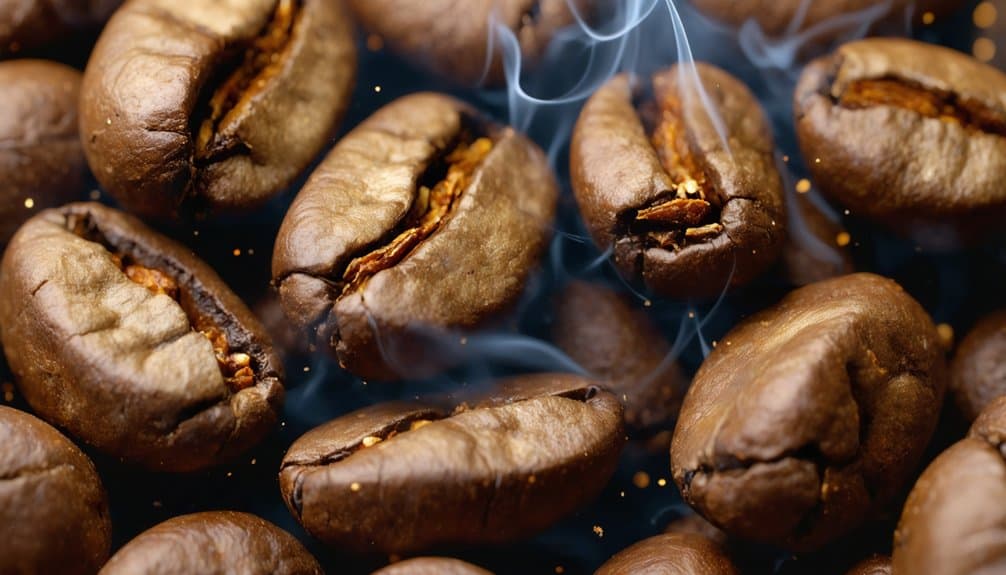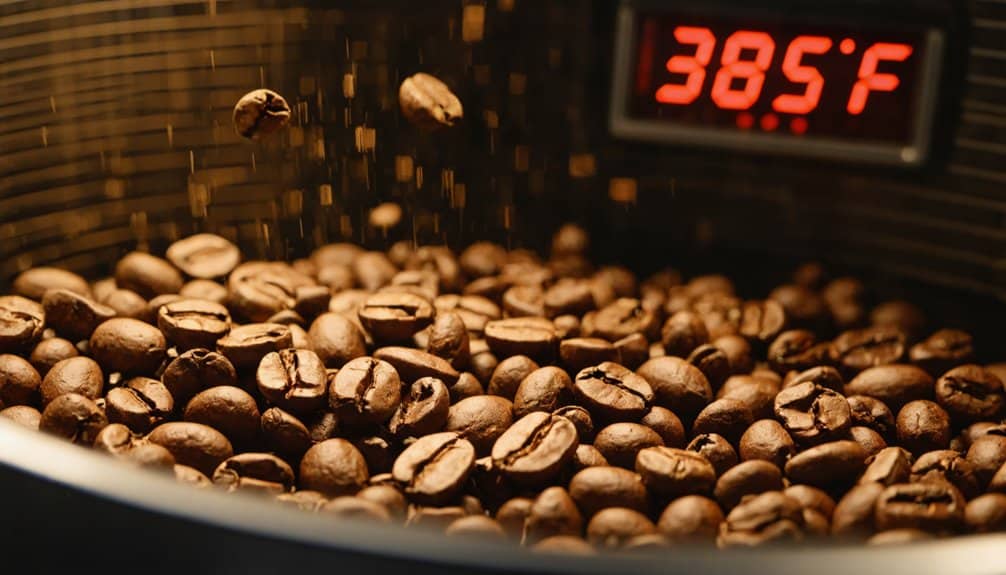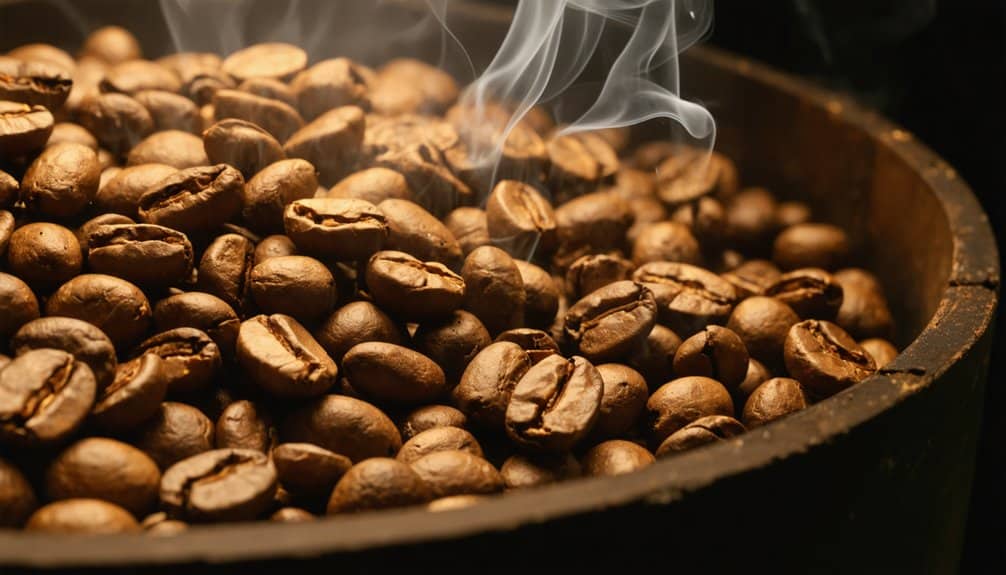You'll identify initial crack in coffee roasting by monitoring three key indicators simultaneously. Watch for temperatures between 385°F to 405°F, listen for distinctive popping sounds similar to popcorn kernels, and observe visual changes as beans transform from green to light brown with rough, uneven surfaces. Managing heat application 10-15 degrees before anticipated crack temperatures helps control development. Each coffee variety exhibits unique crack characteristics, warranting deeper exploration of timing variations and control methods.
Key Takeaways
- Listen for distinct popcorn-like popping sounds between 385°F to 405°F (196°C to 208°C), which start sporadically and increase in frequency.
- Watch for visual changes as beans expand, develop rough textures, and transition from green to light brown color.
- Monitor increased smoke production and steam release, along with chaff separation from beans, indicating first crack is approaching.
- Expect first crack typically around 395°F to 400°F (201°C to 204°C), adjusting for roaster type and bean characteristics.
- Look for beans to physically expand and develop surface cracks while producing loud, distinct cracking sounds over 1:30-1:45 minutes.
Understanding First Crack Temperature Range

When monitoring coffee roasting temperatures, understanding the typical range for initial crack is vital for achieving consistent results. You'll typically encounter primary crack between 385°F to 405°F (196°C to 208°C), with most roasters reporting it around 395°F to 400°F (201°C to 204°C). However, your specific temperature readings may vary based on your roaster type and probe placement.
You'll need to account for variables like moisture content, load size, and altitude, which can influence crack timing. In some cases, with high airflow or specific profiles, you might experience primary crack at temperatures as low as 332°F. During this stage, significant moisture evaporation occurs as the beans undergo their first transformation. Calibrating your equipment guarantees accurate temperature monitoring.
Visual Signs of First Crack Approaching
Beyond temperature readings, mastering visual inspection skills improves your ability to identify initial crack's approach. As your beans progress through the roasting process, you'll notice distinct physical transformations that signal primary crack's imminent arrival.
- Monitor the beans' expansion and surface texture, which becomes increasingly rough and uneven
- Watch for the color shift from raw green to light brown tones
- Look for steam and chaff release, indicating internal moisture conversion
- Observe the beans' structural changes as they begin to break and release oils
You may also notice a significant increase in smoke production as the beans approach first crack. These visual indicators, combined with your temperature monitoring, will help you precisely time your roast development.
Auditory Cues During First Crack

When you're listening for initial crack during coffee roasting, you'll hear distinctive popping sounds that closely resemble popcorn kernels or snapping wooden toothpicks. These sounds will begin sporadically, then increase in both frequency and intensity as more beans reach the vital temperature range of 380-405°F. You'll notice that initial crack produces louder, lower-frequency sounds compared to second crack, making it a pivotal auditory milestone in determining your roast development. During slower roasts, you may experience softer, inaudible cracks that require closer attention to detect.
Distinct Popping Sounds
During primary crack, you'll hear a distinctive sequence of popping sounds that closely resembles popcorn popping, though at a lower frequency and with less consistency. These auditory signals serve as essential markers in your roasting process. First crack occurs when water vapor pressure builds inside the beans, typically at temperatures between 390-405°F.
- Isolated pops emerge initially, gradually building into a continuous series
- Low-frequency acoustic energy characterizes the sound profile
- Well-insulated roasters may dampen the auditory signals
- Metal objects and sight glasses can help amplify these vital sounds
The clarity and intensity of these sounds will vary based on your coffee's density, processing method, and maturation. Dry-processed and lower-density beans typically produce more subtle cracks, while past-crop coffee often yields more pronounced sounds.
Volume and Crack Intensity
The volume and intensity of primary crack can vary dramatically across different roasting scenarios, presenting unique challenges for roasters seeking consistent results. You'll find that bean characteristics, including density and moisture content, greatly influence crack intensity, while your roasting equipment's insulation level can affect audibility. Dense, high-altitude beans typically produce louder cracks than softer, low-altitude varieties. Research shows that fewer than 5% of beans actually produce an audible pop during the first crack phase. Pay attention to your roasting speed, as rapid processes can blur the distinction between primary and second crack. When working with heavily insulated machines or in noisy environments, you'll need to rely on complementary indicators like visual cues and RoR changes.
Managing Heat Application for First Crack
You'll need to anticipate primary crack by reducing heat application approximately 10-15 degrees before the expected crack temperature of 385°F. As you approach this critical phase, maintain steady momentum while avoiding dramatic temperature fluctuations that could disrupt the bean's development. Your precise heat adjustments during this period will establish the foundation for ideal flavor development through primary crack's progression. You can identify the start of first crack when you hear distinct popcorn-like popping sounds from the roasting chamber.
Heat Adjustment Before Crack
Successfully managing heat application before initial crack requires precise control over multiple temperature phases during the roast cycle. You'll need to master both heat soak and heat shock approaches, depending on your beans and desired profile.
Adjusting heat application can dramatically affect flavor development, as shown by roasters from 14 different countries in recent testing.
- Start with charge temperatures between 150-200°C, monitoring the essential turning point within 45-75 seconds
- Apply minimal heat between charging and turning point to establish proper development
- Consider implementing a heat soak approach, starting at 300°F and gradually climbing to 320°F
- Alternatively, utilize heat shock, beginning at 400°F before reducing to 25% burner power at 340°F
Your heat adjustments must account for bean variability, roaster design, and batch size to achieve best possible results.
Maintaining Temperature Control Momentum
When managing heat application during preliminary crack, maintaining precise temperature control becomes increasingly complex due to the beans' change into an exothermic phase. You'll need to reduce heat input approximately halfway through initial crack to prevent rushing into second crack. However, don't reduce too early, as this can cause stalling. Monitor your drum temperature closely, as different roasters and bean varieties require unique adjustments. You'll find that precise thermometry is essential during this phase, particularly when working with machines that have significant hysteresis. Consider how your batch size affects the timing and intensity of crack development. Starting with a higher initial heat is crucial since the roasting process demands the most energy at the beginning.
Factors That Influence First Crack Timing

Several key factors work in concert to influence the timing and characteristics of primary crack during coffee roasting. Understanding these variables will help you achieve consistent results and master your roasting process.
- Bean characteristics, including moisture content and density, greatly impact crack timing – with higher moisture content producing louder, longer cracks. Experienced roasters suggest aiming for a first crack duration of 1:30 to 1:45 minutes for optimal development.
- Your roasting equipment's preheat temperature and heat input directly affect when primary crack occurs
- Environmental conditions like altitude and humidity can alter temperature readings and crack timing
- Your chosen roast profile, particularly the duration of the Maillard phase, shapes how primary crack manifests
Common First Crack Mistakes to Avoid
Mastering primary crack requires avoiding essential errors that can compromise your roast quality and consistency. You'll need to properly preheat and understand your green beans' characteristics to prevent misjudging initial crack timing, which typically occurs between 395-405°F. Don't skip monitoring the pre-initial crack bump, as this can trigger uncontrolled exothermic reactions. Different beans from varying origins and elevations will display unique first crack characteristics.
Stay alert to the initial crack symphony while tracking your roast process meticulously. You'll want to back off heat appropriately and recognize the shift from endothermic to exothermic reactions. Remember, proper cooling is vital, and you must adjust roast times post-initial crack to achieve your desired roast level.
Essential Equipment for Monitoring First Crack

Modern coffee roasting demands four essential categories of monitoring equipment to precisely identify and track primary crack. You'll need an all-encompassing setup to achieve consistent results and maintain control over this pivotal phase of the roasting process. The latest roasting systems offer automatic FC detection for enhanced consistency and precision.
- Specialized roasting machines with integrated primary crack detection systems and BT threshold adjustments
- Wireless temperature monitoring systems featuring high-precision thermocouples and real-time data logging
- Professional software solutions like Cropster or Firescope for live data tracking and profile management
- Acoustic monitoring equipment to analyze sound patterns and differentiate between primary and second crack events
Troubleshooting First Crack Issues
Successful initial crack detection requires systematic troubleshooting when issues arise during the roasting process. If you're experiencing a soft primary crack, it's likely due to low bean moisture or insufficient heat application. You'll need to adjust your roasting parameters accordingly.
Watch for timing irregularities – primary crack occurring beyond 7 minutes in an air roaster can produce an undesirable baked flavor. Early primary crack suggests excessive moisture or rapid heating, requiring a gentler approach. Proper roast development depends on achieving a steadily declining RoR throughout the process. When you notice inconsistent cracking patterns, examine your beans' maturity and moisture content. If primary crack fails to manifest, you're likely dealing with inadequate heat or extended low-temperature exposure.
Techniques for Consistent First Crack Results

You'll need to simultaneously monitor both temperature readings and auditory cues to precisely identify initial crack's onset, maintaining vigilant attention to the distinctive popping sounds that signal this essential phase. To achieve ideal control over the process, you should modulate your heat application methods based on real-time feedback, adjusting between conductive and convective heat transfer as needed. Track the beans' progression from golden to light brown coloration, which serves as a visual confirmation of your approaching initial crack, allowing you to anticipate and respond to changes in roast development. As first crack begins, expect to observe a temporary decrease in bean temperature as water escapes from the beans in an endothermic reaction.
Monitor Temperature and Sound
Through precise monitoring of both temperature and auditory cues, roasters can accurately identify and control the critical primary crack phase. You'll achieve peak results by integrating wireless data loggers and leveraging temperature curves to anticipate and confirm primary crack development. The T&D RTR-505B-TC logger provides real-time temperature displays for consistent roasting outcomes.
- Monitor bean temperature between 390°F and 410°F for the distinctive popping sound
- Track ET ROR curves for the characteristic upward arc indicating imminent primary crack
- Listen for two or more beans cracking within a 3-second window to confirm start
- Maintain consistent batch timing with primary crack lasting 1:30 to 1:45 minutes
Use automated detection systems and customize trigger settings to improve your roasting precision and repeatability.
Adjust Heat Application Methods
Mastering heat application methods during the roasting process requires a strategic balance between heat soak and heat shock techniques. You'll need to choose between gradual heat build-up (heat soak) for consistent initial crack development or high initial heat followed by quick reduction (heat shock) for precise timing control.
Understanding coffee bean density helps determine the optimal heat application timing for your batch. To optimize your approach, combine conductive heat in the early stages with convective heat as you progress. You can fine-tune your results by adjusting drum speed and airflow. Remember, your choice between these methods should align with your desired flavor profile and your roaster's specific characteristics.
Track Bean Color Changes
While heat application sets the foundation for your roast, precise color tracking serves as a visual roadmap to preliminary crack. Understanding these visual cues helps you anticipate and prepare for primary crack with greater accuracy.
- Monitor the shift from green to bright olive during the drying phase at 140°C
- Look for yellowing around 165°C, signaling the start of Maillard reactions
- Watch for tan coloration and mottling at 180-185°C, indicating imminent primary crack
- Observe the final shift to full brown as beans enter primary crack
These color stages reflect significant chemical changes occurring within your beans, making them reliable indicators of roast progression and development. Using a special color meter, roasters can precisely measure these color changes on the Agtron scale for consistency.
First Crack's Impact on Coffee Flavor Development
As coffee beans reach the crucial temperature of 196°C (385°F), they undergo a remarkable transformation known as primary crack, which fundamentally shapes the coffee's flavor development. You'll witness an exothermic reaction where moisture and CO2 release creates that distinctive popping sound, similar to popcorn. Experienced roasters often rely on acoustic detection techniques to identify the onset of first crack.
The duration of primary crack directly influences your roast profile. A one-minute crack yields lighter, brighter flavors, while extending to two or three minutes develops medium to darker profiles. Your roasting precision matters – factors like moisture content, heating rate, and bean density will affect the crack's intensity and duration, ultimately determining your coffee's complexity.
FAQs
Can First Crack Occur Twice in the Same Roasting Session?
You won't experience initial crack twice during a single roasting session. It's a one-time event marking the essential shift from green to light roast, occurring at approximately 385°F (196°C).
Does Altitude Affect the Temperature at Which First Crack Happens?
You'll find that altitude notably affects initial crack temperatures, with higher elevations showing cracks at lower temps – sometimes as much as 20°F below sea-level readings on your roasting equipment.
How Does Bean Density Influence the Sound Intensity of First Crack?
You'll find that denser beans create louder initial crack sounds due to higher internal pressure build-up, while less dense beans produce subtler sounds during the critical pressure-release moment of roasting.
Should I Adjust Fan Speed During First Crack?
When your beans hit initial crack, you'll want to reduce fan speed by 10-20% to maintain thermal momentum, but stay vigilant – you'll need enough airflow to prevent scorching and guarantee even development.
Does Bean Age Impact the Timing and Intensity of First Crack?
Yes, your beans' maturity greatly influences initial crack timing and intensity. Older beans typically crack earlier and softer due to lower moisture content, while fresher beans produce louder, longer-lasting cracks.
The Bottom Line
You'll find that mastering initial crack identification becomes second nature, much like a conductor who anticipates the crescendo in a symphony. By maintaining precise temperature control (typically 385-405°F), monitoring visual cues, and recognizing the distinctive auditory signatures, you're ensuring ideal flavor development. When you've calibrated your sensory awareness to initial crack's nuances, you'll consistently achieve the roast development levels your specialty coffee demands.